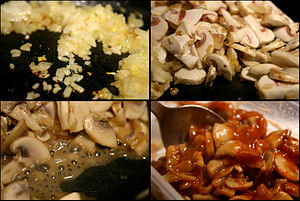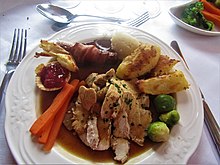Gravy
 Stages in the preparation of mushroom gravy | |
| Main ingredients | Juices of meats that run naturally during cooking, wheat flour, cornstarch |
|---|---|
Gravy is a sauce often made from the juices of meats that run naturally during cooking and often thickened with corn starch or other thickeners for added texture. The gravy may be further coloured and flavoured with gravy salt (a simple mix of salt and caramel food colouring) or gravy browning (gravy salt dissolved in water) or ready-made cubes. Powders can be used as a substitute for natural meat or vegetable extracts. Canned and instant gravies are also available.[1] Gravy is commonly served with roasts, meatloaf, rice,[2] noodles, chips (fries), mashed potatoes, or biscuits (North America, see biscuits and gravy).
History[edit]
Based on current understanding of what a gravy is at its core (a sauce made from meat drippings combined with a thickening agent), one of the earliest recorded instances of a gravy being used is from The Forme of Cury, a cookbook from the 14th century.[citation needed] The term "gravy" is believed to be derived from the French word "gravé" that is found in many medieval French cookbooks.[3]
Types[edit]
This section needs additional citations for verification. (July 2021) |
- See also Wiktionary > gravy § Hyponyms
- Brown gravy is the name for a gravy made from the drippings from roasted meat or fowl. The drippings are cooked on the stovetop at high heat with onions or other vegetables, and then thickened with a thin mixture of water and either wheat flour or cornstarch.
- Cream gravy or white gravy (sawmill gravy) is a bechamel sauce made using fats from meat—such as sausage or bacon—or meat drippings from roasting or frying meats. The fat and drippings are combined with flour to make a roux, and milk is typically used as the liquid to create the sauce, however cream is often added or may be the primary liquid. It is frequently seasoned with black pepper and complimenting herbs and bits of meat may be added such as sausage or diced chicken liver. It is an important part of many Southern USA meals, and frequently used as an ingredient in casseroles and other southern dishes, such as biscuits and gravy and served alongside many Southern favorites such as mashed potatoes, fried chicken and chicken-fried steak.[4] Other common names include country gravy, sawmill gravy, milk gravy, and sausage gravy.
- Egg gravy is a variety of gravy made starting with meat drippings (usually from bacon) followed by flour being used to make a thick roux. Water, broth, or milk is added and the liquid is brought back up to a boil, then salt and peppered to taste. A well-beaten egg is then slowly added while the gravy is stirred or whisked swiftly, cooking the egg immediately and separating it into small fragments in the gravy.
- Red gravy can refer to several different dishes. It is a simple, basic tomato sauce in New Orleans.[5] In the Italian American communities it refers to a complex long- and slow-cooked tomato sauce, frequently with meats and vegetables,[6] although the distinction between "sauce" and "gravy" in the Italian tomato world is debated.[7] There are several red gravies from India, which are variations of tomato-based curry.[8]
- Giblet gravy has the giblets of turkey or chicken added when it is to be served with those types of poultry, or uses stock made from the giblets.
- Mushroom gravy is a variety of gravy made with mushrooms.
- Onion gravy is made from large quantities of slowly sweated, chopped onions mixed with stock or wine. It is commonly served with bangers and mash, eggs, chops, or other grilled or fried meat which by way of the cooking method would not produce their own gravy.
- Red-eye gravy is a gravy made from the drippings of ham fried in a skillet or frying pan. The pan is deglazed with coffee, giving the gravy its name, and uses no thickening agent. This gravy is a staple of Southern United States cuisine and is usually served over ham, grits or biscuits.
- Vegetable gravy or vegetarian gravy is gravy made with boiled or roasted vegetables. A quick and flavourful vegetable gravy can be made from any combination of vegetable broth or vegetable stock, flour, and one of either butter, oil, or margarine. One recipe uses vegetarian bouillon cubes with cornstarch (corn flour) as a thickener ("cowboy roux"), which is whisked into boiling water. Sometimes vegetable juices are added to enrich the flavour, which may give the gravy a dark green colour. Wine could be added. Brown vegetarian gravy can also be made with savoury yeast extract like Marmite or Vegemite. There are also commercially produced instant gravy granules which are suitable for both vegetarians and vegans, though some of the leading brands are not marketed as being vegetarian.
Cuisines[edit]
This section needs additional citations for verification. (July 2021) |


In the United Kingdom and Ireland, a Sunday roast is usually served with gravy. It is commonly eaten with beef, pork, chicken or lamb. It is also popular in different parts of England, Scotland, Wales and Ireland to have gravy with just chips (mostly from a fish and chip shop or Chinese takeaway).
In British and Irish cuisine, as well as in the cuisines of Commonwealth countries like Australia, Canada and New Zealand, the word gravy refers only to the meat-based sauce derived from meat juices, stock cubes or gravy granules. Use of the word "gravy" does not include other thickened sauces. One of the most popular forms is onion gravy, which is eaten with sausages, Yorkshire pudding and roast meat.
Throughout the United States, gravy is commonly eaten with Thanksgiving foods such as turkey, mashed potatoes and stuffing. One Southern United States variation is sausage gravy eaten with American biscuits. Another Southern US dish that uses white gravy is chicken-fried steak. Rice and gravy is a staple of Cajun and Creole cuisine in the southern US state of Louisiana.
Gravy is an integral part of the Canadian dish poutine. In Quebec, poutine gravy is thin, and is sometimes a mix of beef and chicken stock. Other places in Canada use a thicker gravy, similar to an American gravy.
In some parts of Asia, particularly India, gravy is any thickened liquid part of a dish. For example, the liquid part of a thick curry may be referred to as gravy.[9][10]
In the Mediterranean, Maghreb cuisine is dominated with gravy and bread-based dishes. Tajine and most Maghreb (Morocco, Algeria and Tunisia) dishes are derivatives of oil, meat and vegetable gravies. The dish is usually served with a loaf of bread. The bread is then dipped into the gravy and then used to gather or scoop the meat and vegetables between the index, middle finger and thumb, and consumed.
In gastronomy of Menorca, it has been used since the English influence during the 17th century in typical Menorcan and Catalan dishes, as for example macarrons amb grevi (pasta).[11]
See also[edit]
- Au jus - beef juice
- Cuisine of the Southern United States
- Gravy train (disambiguation)
- List of sauces
- Sauce boat, also referred to as a gravy boat
References[edit]
- ^ Peter, K.V. (2012). Handbook of Herbs and Spices. Woodhead Publishing Series in Food Science, Technology and Nutrition. Elsevier Science. p. 112. ISBN 978-0-85709-567-1. Retrieved May 23, 2017.
- ^ "Rice and Gravy | RealCajunRecipes.com: la cuisine de maw-maw!". RealCajunRecipes.com. January 1, 1970.
- ^ "Gravy". Encyclopedia.com. Retrieved 2022-06-18.
- ^ "Homemade Southern Cream Gravy With Drippings". The Spruce Eats.
- ^ "New Orleans Red Gravy". www.gumbopages.com.
- ^ "Do You Prefer Sauce or Gravy?".
- ^ "Let's Finally Settle the Decades-old Sauce vs. Gravy Debate". 17 May 2020.
- ^ "Restaurant Style Red Gravy: All-purpose curry base". www.vegetariantastebuds.com/.
- ^ Basic Indian gravy
- ^ "List of Indian gravy dishes". Archived from the original on December 11, 2009.
- ^ Xim Fuster i Manel Gómez: Menorca: gastronomía y cocina. Sant Lluís. 2005. Ed. Triangle Postals. ISBN 84-8478-187-9
